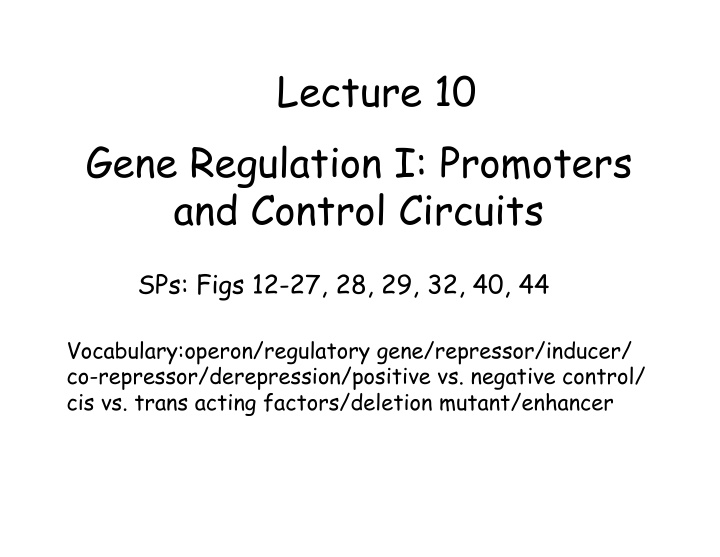



Lecture 10 Gene Regulation I: Promoters and Control Circuits SPs: Figs 12-27, 28, 29, 32, 40, 44 Vocabulary:operon/regulatory gene/repressor/inducer/ co-repressor/derepression/positive vs. negative control/ cis vs. trans acting factors/deletion mutant/enhancer
Operon Structure Fig 12-28
Lactose metabolism in E. coli Lactose= disaccharide of galactose + glucose Lactose (inducer) β -galactosidase expressed glucose + lactose galactose
Inducible Operon: The Lac operon If Lac present, repressor inactivated Fig 12-29 Operon induced, mRNA transcribed This is ‘Induction’
Translation of mRNA yields 3 enzymes that convert: Lactose Glucose + Galactose
What happens when lactose supply is reduced? Binding of lactose to repressor is transient, so as [lactose] falls, repressor becomes active Repressor now able to bind to the operator Repression occurs: transcription blocked
Repressible Operon: TRP Operon Used to make the amino acid tryptophan Default is ON, unless TRP is present • If TRP present, repression occurs • TRP acts as corepressor Fig 12-29
Repressed state: no TRP production As TRP used, [TRP] falls Thus no co-repressor present & repressor no longer functions Derepression (reactivation) occurs
mRNA processed and translation yields 5 enzymes that convert precursors to tryptophan
Cis vs. Trans: ‘Cis-acting promoter sequence to which a trans-acting transcription factor binds Trans: (trans-acting/ e.g. a transcription factor) promoter Coding region Cis: “ on the same strand ” ; e.g. DNA sequence that serves as a binding site for a TF. Positive vs. negative control : depends on the active form of the trans-acting factor (e.g. repressor), and its effect upon binding to its target cis-acting sequence.
Bacterial Biochemical Logic for LAC=GLU + GAL 1. If glucose is available, why expend energy to make enzymes to catabolize lactose? 2. If lactose is absent, why expend energy to make enzymes to catabolize it? Both positive and negative control involved. Positive control: if glucose level is low, cAMP level is high; cAMP binds to CRP, and the complex activates the lac operon.
Four situations: sugar availability and positive/negative control Allolactose: an isomer of lactose, is the actual inducer Brooker Fig 12.11
There are four LAC operon and two TRP operon animation links available on Blackboard- have a look!
Overview of levels of control of gene expression Fig 12-32 Post-translational control also may exist
Transcription level control:identifying promoter motifs promoter TATA box Coding region Components involved: 1. Recombinant DNA methods to alter sequences • ‘ Reductionist ’ approach: remove/alter sequence 2. Method of transforming cells of interest 3. Method of evaluating transcription • Hybridization using radioactive probe • Reporter gene technology
Step 1: Altering cloned DNA Recombinant DNA methods permit almost any change to your favorite gene (YFG) YFG ? ? ? TATA box Deletions: YFG YFG Site-directed mutagenesis is also possible: Example: 5 ’ -GACCATGCT- changed to: 5 ’ -GACTATGCT-
Step 2: Transform target cells with the altered DNA • Typically this was the original ‘ host ’ • Many methods available to transform cells • ‘ Transgenic ’ organism produced. Step 3: Analysis of expression of the ‘ transgene ’ • Problem: how to analyze? Endogenous (normal gene) already present, interferes with analysis of the altered DNA • Solution? Use a ‘ reporter gene ’ e.g: β -galactosidase or Green fluorescent protein (GFP)
Reporter genes: examples Fig 12-33 MYO:: β -galactosidase in FIL::GFP shows expression mouse embryo: muscle on the dorsal face of development floral organs: symmetry Histochemical staining/fluorescence reveal expression pattern
Analysis of deletion mutants defines cis-acting regulatory sequences 6. Deletion in this region = higher levels of product A negative element has been removed by deletion. Fig 12-40
Many promoters contain binding sites for a number of proteins that can influence transcription. Fig 12-43 Multiple binding sites: provide fine control over expression and the ability to respond to multiple signals.
Enhancers: • DNA elements often located far away from the gene they control. • Orientation independent. Why?
Fig 12-44 2 1 1. Chromatin modifications 2. Interactions with general transcription machinery
Transcription factors: Protein factors that influence transcription Positive and/or negative roles: e.g. may act to activate one gene and repress another Next class: Transcription factors and microarray (gene chip) technology
Recommend
More recommend